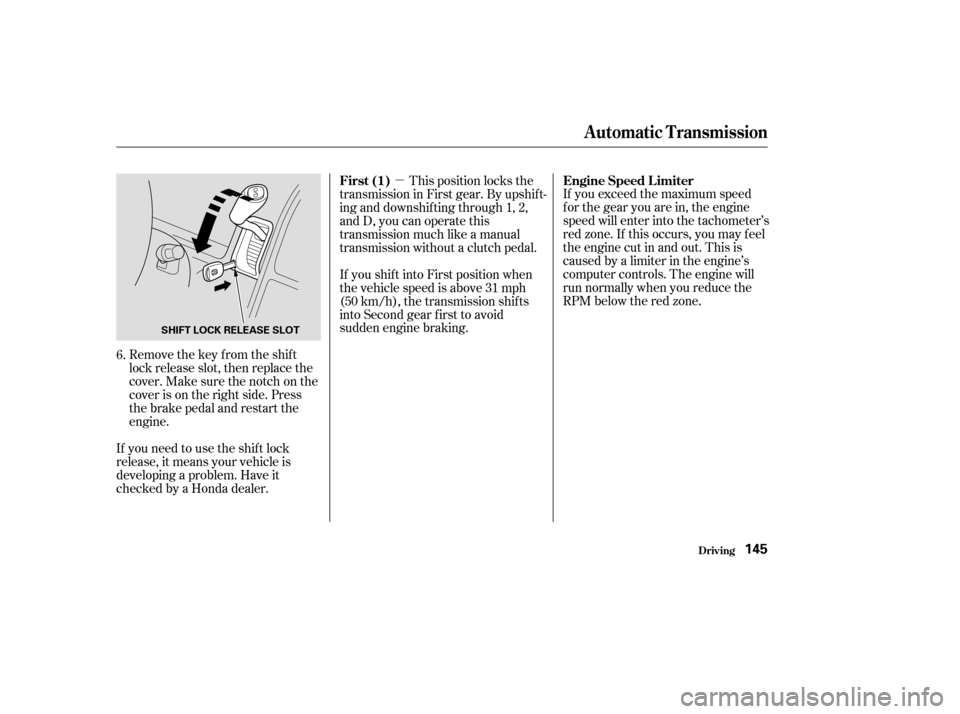Page 148 of 256

�µ
WhentheOver-driveisoff,the
transmission selects only the f irst
three gears. Use it to provide engine
braking when going down a steep hill,
or keep the transmission f rom
cycling between third and f ourth
gears in stop-and-go driving.
This position locks
the transmission in second gear. It
does not downshif t to f irst gear
when you come to a stop.
Use Second gear:
For more power when climbing.
To increase engine braking when
going down steep hills.
For starting out on a slippery
surf ace or in deep snow.
To help reduce wheel spin. When driving downhill with a
trailer.
Do this if pushing on the brake pedal
and pulling the shif t lever does not
shif t the transmission out of Park: Set the Parking brake.
Make sure the ignition switch is in
the LOCK (0) position.
To release the reverse lockout,
make sure the ignition switch is in
the ACCESSORY(I) position.
Put a cloth on the edge of the shif t
lock release slot cover next to the
shif t lever. Using a key, caref ully
pry on the edge of the cover to
remove it. Insert a key into the shift lock
release slot.
To release the reverse lockout,
move the shift lever from Neutral
to Reverse, then to Park. Push down on the key and move
the shift lever out of Park to
Neutral.
1.
2.
3.
4.
5.
Second (2)
Shif t L ock Release
Automatic Transmission
Driving144
COVER
Page 149 of 256

�µIf you exceed the maximum speed
f or the gear you are in, the engine
speed will enter into the tachometer’s
red zone. If this occurs, you may f eel
the engine cut in and out. This is
caused by a limiter in the engine’s
computer controls. The engine will
run normally when you reduce the
RPM below the red zone.
This position locks the
transmission in First gear. By upshif t-
ing and downshif ting through 1, 2,
and D, you can operate this
transmission much like a manual
transmission without a clutch pedal.
If you shif t into First position when
the vehicle speed is above 31 mph
(50 km/h), the transmission shif ts
into Second gear f irst to avoid
sudden engine braking.
Remove the key from the shift
lock release slot, then replace the
cover. Make sure the notch on the
cover is on the right side. Press
the brake pedal and restart the
engine.
If you need to use the shif t lock
release, it means your vehicle is
developing a problem. Have it
checked by a Honda dealer. 6. Engine Speed L imiter
First (1)
Automatic Transmission
Driving145
SHIFT LOCK RELEASE SLOT
Page 150 of 256

Always use the parking brake when
you park your vehicle. Make sure
the parking brake is set f irmly or
your vehicle may roll if it is parked
on an incline.
If your vehicle has an automatic
transmission, set the parking brake
bef ore you put the transmission in
Park. This keeps the vehicle f rom
moving and putting pressure on the
parking mechanism in the
transmission.Make sure the moonroof and the
windows are closed.
Turn of f the lights.
Place any packages, valuables, etc.
in the cargo area, or take them
with you.
Lock the doors and the tailgate.
Make sure the hatch glass is
closed securely.
Never park over dry leaves, tall
grass, or other f lammable
materials. The hot three way
catalytic converter could cause
these materials to catch on fire.If the vehicle is f acing uphill, turn
the f ront wheels away f rom the
curb.
If the vehicle is f acing downhill,
turn the front wheels toward the
curb.
Make sure the parking brake is
f ully released bef ore driving away.
Driving with the parking brake
partially set can overheat or
damage the rear brakes.
Parking T ips
Driving
Parking T ips
146
Page 159 of 256

CONT INUED
The added weight, length, and
height of a trailer will af f ect your
vehicle’s handling and perf ormance,
so driving with a trailer requires
some special driving skills and
techniques.Make turns more slowly and wider
than normal. The trailer tracks a
smaller arc than your vehicle, and it
canhitorrunoversomethingthe
vehicle misses. Allow more time and
distance f or braking. Do not brake or
turn suddenly as this could cause the
trailer to jackknif e or turn over.When climbing hills, closely watch
your temperature gauge. If it nears
the red mark, turn the air
conditioning of f , reduce speed and, if
necessary, pull to the side of the
road to let the engine cool.
If the automatic transmission shif ts
f requently between 3rd and 4th
gears while going up a hill, turn of f
the Over drive (O/D) mode (see
page ).
If youmuststopwhenfacinguphill,
use the f oot brake or parking brake.
Do not try to hold the vehicle in
placebypressingontheaccelerator,
as this can cause the automatic
transmission to overheat.
Foryoursafetyandthesafetyof
others,taketimetopracticedriving
maneuvers bef ore heading f or the
open road, and f ollow the guidelines
discussed below. Drive slower than normal in all
driving situations, and obey posted
speed limits f or vehicles with trailers.
If you have an automatic
transmission, use over drive (O/D)
when towing a trailer on level roads.
Turn of f the over drive (O/D) mode
when towing a trailer in hilly terrain.
(see ‘‘
’’ in the next
column f or additional gear
inf ormation.) 143
Trailer Driving Tips
Driving
Driving Saf ely With a T railerT owing Speeds and Gears
Making T urns and Braking Driving on Hills
Driving on Hills
155
Page 160 of 256

Always drive slowly and have
someone guide you when backing up.
Grip the of the steering
wheel; then turn the wheel to the lef t
to get the trailer to move to the lef t,
andturnthewheelrighttomovethe
trailer to the right.
Crosswinds and air turbulence
caused by passing trucks can disrupt
your steering and cause trailer
swaying. When being passed by a
large vehicle, keep a constant speed
and steer straight ahead. Do not try
to make quick steering or braking
corrections.Follow all normal precautions when
parking, including f irmly setting the
parking brake and putting the
transmission in Park (automatic) or
in 1st or Reverse (manual). Also,
place wheel chocks at each of the
trailer’s tires.
When driving down hills, reduce
your speed and shif t down to 3rd
gear on the manual transmission,
and turn off the Over drive (O/D)
mode on the automatic transmission.
Do not ‘‘ride’’ the brakes.
bottom
Trailer Driving Tips
Driving
Backing Up
Handling Crosswinds and Buf f et ing Parking
Remember: It will take longer to
slow down and stop when towing
atrailer.
156
Page 161 of 256

Your Honda can be towed behind a
motorhome at legal highway speeds
up to 65 mph(100 km/h). Do not
exceed 65 mph(100km/h).
Otherwise, severe transmission
damage will occur. To avoid damage
to the 4WD system, it must be towed
with all f our wheels on the ground
(f lat towing).
When purchasing a tow bar, make
sure you select a reputable
manuf acturer and installer. Follow
the manufacturer’s attachment
instructions caref ully.Perf orm the f ollowing procedure
everyday immediately bef ore you
begin towing. Otherwise severe
automatic transmission damage will
occur.
Check the transmission f luid level
(see page ).
Start the engine.
Press on the brake pedal. Move
the shif t lever through all its
positions.
ShifttoD,thentoN.Letthe
engine run f or three minutes, then
turn it off.
Leave the ignition switch in
ACCESSORY (I) so the steering
wheel does not lock. Make sure
the radio and any items plugged
into the accessory power sockets
are turned of f so you do not run
down the battery. If you tow more than 8 hours in one
day, you should repeat the above
procedure at least every 8 hours
(when you stop f or f uel, etc.)
Release the parking brake. 179
Do not overf ill.
Driving
Towing Your Vehicle Behind a Motorhome
Ext ended T owing
157
NOTICE:
NOTICE:T he steering system can be
damaged if the steering wheel is locked.
Leave the ignition switch in Accessory
(I), and make sure the steering wheel
turns f reely bef ore you begin towing.
Failure to f ollow the above
instructions exactly will result in severe
automatic transmission damage. If you
cannot shif t the transmission or start
the engine, your vehicle must be
transported on a f lat-bed truck or
trailer.
Page 162 of 256

When towing your CR-V f or long
periods, remove the 7.5A Accessory/
Radio f use to reduce drain on battery.
This f use in located in the interior
f use box and is shown as number 8
below.
Only remove the fuse after you have
perf ormed the transmission shif ting
procedure, and the key is in the
ACCESSORY (I) position. Store the
f use in an obvious location (center
tray, coin pockets, etc) as a reminder
to re-install the fuse before driving
the vehicle.If youtowaCR-Vwithanautomatic
transmission, the transmission f luid
must be changed every two years or
30,000 miles (48,000 km), whichever
comes f irst.
Towing Your Vehicle Behind a Motorhome
Driving
Automatic Transmission
Ext ended T owing
158
NOTICE:INTERIOR FUSE BOX
ACC/RADIO FUSEThis f use MUST be re-
installed bef ore driving the vehicle.
Failure to re-install the f use may allow
youtoremovethekeywiththe
transmission in gear.
Severe automatic transmission damage
will occur if the vehicle is shif ted f rom
reverse to neutral and then towed with
the drive wheels on the ground.
Page 165 of 256

Avoid driving through deep water. If
you encounter water in your route (a
small stream or large puddle, f or
example), evaluate it carefully before
going ahead. Make sure it is shallow,
f lowing slowly, and has f irm ground
underneath. If you are not sure of
the depth or the ground, turn around
andfindanotherroute.
Driving through deep water can also
damage your vehicle. The water can
get into the transmission and
dif f erential, diluting the lubricant
and causing an eventual failure. It
can also wash the grease out of the
wheel bearings.Avoid driving on sof t sand, deep mud,
or other surf aces where you could
get stuck. If you do happen to get
stuck because of inclement weather
or other conditions, choose a saf e
and appropriate course of action.
You should never use a jack to try
getting unstuck. A jack only works
on f irm, level ground. Also, your
vehicle could easily slip of f the jack
and hurt you or someone else.
If you spin the wheels excessively
trying to get unstuck, you may
overheat the components of the
4-wheel drive system. If this happens,
the 4-wheel drive system shuts off
and only the f ront wheels receive
power. If this happens, stop and
allow everything to cool down. The
4-wheel drive system will work again
after its temperature drops.
If you slip the clutch f or a long time
while trying to get unstuck, you may
overheat and damage it.
Of f -Highway Driving Guidelines
If You Get Stuck
Crossing a Stream4-Wheel Drive Vehicles
Driving161